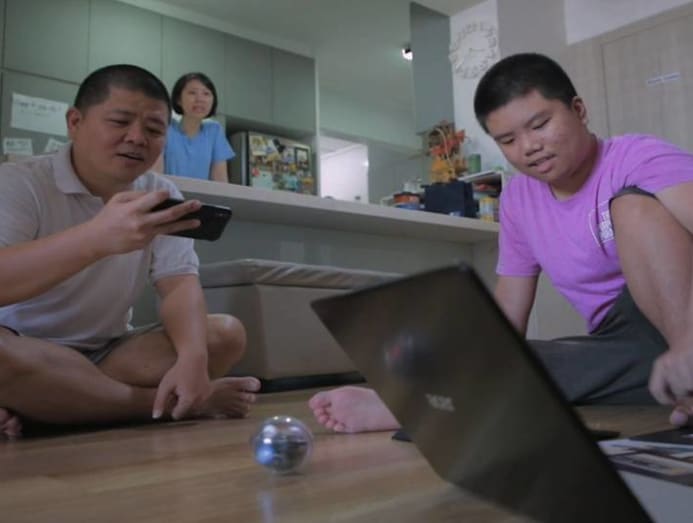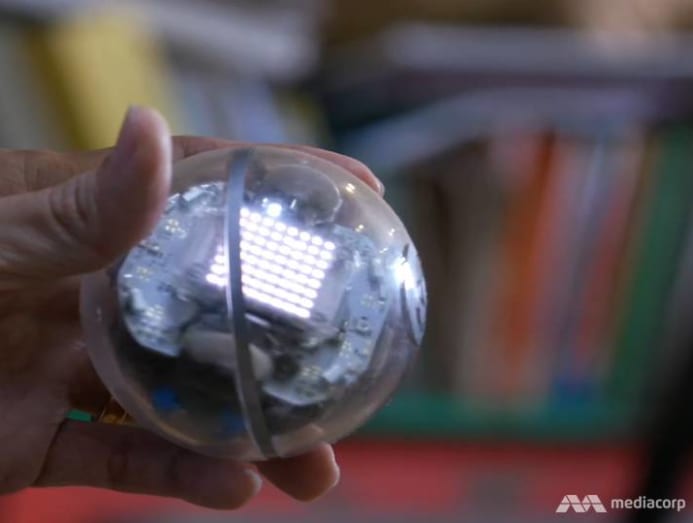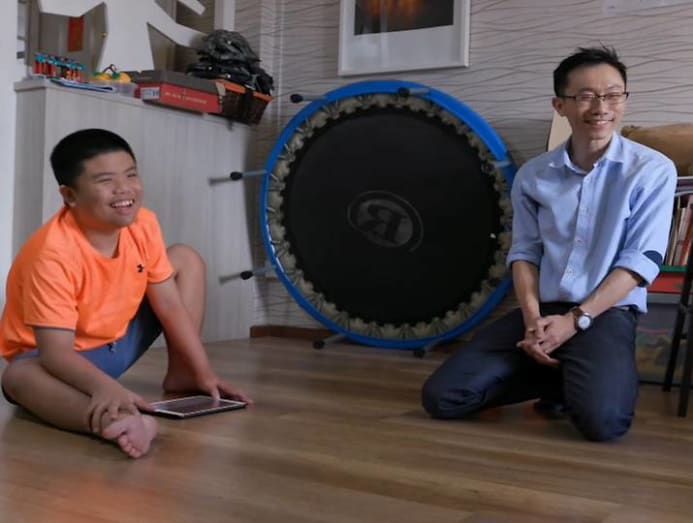How technology gives my son hope with his autism
Virtual reality and robotic devices can be used to empower those on the autism spectrum and even open up job possibilities for them, the series Gadg(AID) finds out.

Lim Hwee Hwee comforting her son, Lee Jun Le, after he had a meltdown. (Source: Bob Lee)
SINGAPORE: Lee Jun Le is 13 years old and, many times, finds it difficult to convey how he feels or express what he means to say.
He can also have sudden, unexplained meltdowns, which often confound his parents. “When there’s a meltdown, he can’t tell us why he’s upset. Sometimes he’d cry for no reason,” said his mother Lim Hwee Hwee. “So we have to guess.”
He has an autism spectrum disorder (ASD). And even a change in his routine, such as going to the supermarket without giving him prior notice, can overwhelm him with feelings of frustration.
His parents often end up apologising to others and saying he behaved the way he did because he is a special needs child. “We call ourselves the sorry, sorry parents. Sorry, sorry, sorry,” dad Bob Lee said half-jokingly.

Jun Le is often a boy misunderstood. But technology can make life a little easier for persons like him on the autism spectrum and for their caregivers too. The series Gadg(AID) looks at three ways in which technology can help. (Watch this episode here.)
1. USING VIRTUAL REALITY TO UNDERSTAND THEIR CONDITION
Those with ASD often experience the world differently from most people. And that is where virtual reality (VR) technology comes in.
The National Autistic Society in the United Kingdom created a VR film called Too Much Information, to give people a better idea of how those with autism feel when they experience a sensory overload.
The film contains lots of bright colours, flashing lights and loud, sudden noises to transport people to a different world.
National Autistic Society’s autism access specialist Chris Pike said: “It could be much easier to understand why an autistic person might be behaving in the way they are.”

For example, the light on a television screen can feel more intense for one with ASD than it is for someone else. Even the smell of perfume can be overwhelming.
After Jun Le’s parents watched the VR film, Lee said it served as a reminder of why their son sometimes has meltdowns, and how they sometimes forget that persons with autism are sensitive to certain things.
For example, Jun Le sometimes covers his ears in busy shopping centres, as he is sensitive to high-pitched and low-pitched noises. Said Lee: “Sometimes we forget about … other things, other triggers (that) maybe we missed.”
2. SIMULATING REAL-LIFE SITUATIONS
Street sounds can also cause Jun Le to have a meltdown, which his parents have seen in the past year in their attempts to teach him to travel independently.
One of the things they get him to practise is to cross the road safely at traffic junctions. But he has no sense of danger and can easily be distracted.

At Tech Able in the Enabling Village, a simulator called the iMirror lets people with special needs rehearse these real-life scenarios.
This interactive software, which is equipped with motion sensors and uses VR technology, can help to teach basic travelling skills to those with disabilities, including how to top an ez-link card up and how to cross the road.
“It simulates the local environment, and it helps them to get used to the environment in a safe place,” said SG Enable head of technology catalyst Alvin Tan.
When Jun Le tried this assistive technology, he was coached by his former occupational therapist New Wei Ling. He managed to complete the tasks with ease.
WATCH: What's the future for our autistic son? (6:35)
The senior occupational therapist with TLC Speech Clinic said that in a real situation, individuals with autism can be overwhelmed by the sensory information from the surroundings.
“The benefit of being able to learn in a controlled environment is … we can help them to learn the fundamentals first, for example the safety aspect (of crossing the road),” she said.
3. LEARNING CODING SKILLS WITH A ROBOTIC BALL
In school, Jun Le gets only an hour of information technology lessons each week. He learns Scratch, a programming language.
Some people with ASD excel in programming, as they think highly logically, in a literal step-by-step manner. And they enjoy the predictability of code, where every action is a result of a command.
In Australia, a high school for children with autism has found a device called Sphero to help its students learn better.

This programmable robot ball can roll around, light up and make sounds. It is remotely controlled via a smartphone or tablet, and its behaviour can also be pre-programmed using code.
Craig Smith, a school co-ordinator for Autism Spectrum Australia, said that with Sphero, students can learn coding outside the classroom and not be stuck in front of a computer.
There are also similarities between the language of coding and the way students on the autism spectrum are taught, he pointed out.
“We might say, ‘Here’s what you need to put on to get dressed before you go to school.’ And the sort of sequence … is very similar to the sort of sequences that you’d use in coding,” he said.

That is similar to the specific, step-by-step instructions Jun Le’s parents give him before he performs any task, including using the toilet.
Computhink founder David Lee, who specialises in teaching coding to children, has coached kids with ASD. And in two sessions, he taught Jun Le to control the Sphero using simple codes.
He observed that the boy seemed to enjoy the sessions and could programme the robot to move in a straight line as well as in the shape of a square.
And what might start out as play-based, fun activities could make a viable career in future.

“(Jun Le) is able to follow instructions very well. So we can take a look at (job) roles that require these skills, like testing,” said Computhink’s Lee.
“The tester would look at the test script, and he’d tick (it off) step by step and make sure that the programmes are supposed to work exactly as (they’re) coded.”
Watch this episode of Gadg(AID) here.





